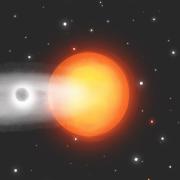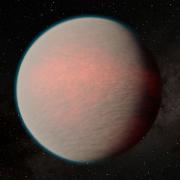It is a major goal of astronomical research to find planets other than Earth that might be suitable for sustaining life. There are a number of factors which many scientists agree are essential to a planet being habitable, but an important one is whether or not a planet has an atmosphere.
Scientists have found other rocky, Earth-like exoplanets, but none that we can definitively say have atmospheres. Finding these planets will reveal insights into how such atmospheres are formed and retained, so that we can better predict which planets could be habitable.
A study conducted by University of Chicago PhD student Qiao Xue with Prof. Jacob Bean’s group has demonstrated a new way to determine if faraway exoplanets have an atmosphere—and showed that it was simpler and more efficient than previous methods. The new technique, when applied to more planets, has the potential to help us learn more about patterns in atmosphere formation.
“When we look at a large enough data set, as we will this year with the James Webb Space Telescope, we are hoping to find trends to help us understand more about atmosphere formation—and what makes planets habitable,” said Xue.
The search for atmospheres
As scientists try to understand the conditions on other faraway planets, they would like to know whether or not a planet has an atmosphere—a gaseous layer that insulates the planet and regulates its temperature. On Earth, for example, our atmosphere redistributes the sun’s heat around the planet, keeping it a temperate place for life.
Scientists cannot, however, directly image rocky, Earth-like planets close to their stars. Instead, they must piece together different clues, such as the fluctuations in light as the planet moves around its host star.
In the study, the scientists used a method that was proposed in 2019 by a collaboration including Bean and Megan Mansfield (PhD’21, now with the University of Arizona) to look for atmospheres. The approach uses the difference in temperature between an exoplanet measured at its hottest and the calculated temperature of how hot it could theoretically be.
Since atmospheres disperse heat around the entire surface area of planets, they reduce the temperature of the hottest side of the planet (which faces the star directly). The scientists hypothesized that if an exoplanet’s actual temperature is not as hot as it could theoretically be, then we can presume it has an atmosphere performing this function.
The trouble was, however, that we have lacked instruments precise enough to provide accurate enough readings for these temperatures. The James Webb Space Telescope has changed that—offering an increased capacity to see in the infrared, which allows for scientists to record the temperatures of the planets by measuring the intensity of energy they emit.
Above, an animation from NASA demonstrating the fluctuations in the amount of light observed emitting from the system as the exoplanet orbits the star.
When exoplanets cross in front of their suns, they obscure some of the star’s light, leading to a slight decrease in the star’s measured brightness. When the planet appears almost behind the star relative to our viewing devices, we can capture the maximum brightness of the system—that is, the unobscured star combined with the comparatively minimal light emitted from the planet. When the planet crosses behind the star relative to our view, we can record the light emitted by the star on its own. By subtracting this measurement of light from the measurement of the light of the star combined with the light of the planet, the brightness—and thus the temperature—of the planet on its own can be deduced.
In this way, Xue concluded that the first planet to which she applied the new method, planet GJ1132 b, does not have an atmosphere—the measured temperature of the planet is too close to the calculated maximum temperature to be suggestive of any temperature-regulating component of the planet. “It is therefore not a suitable candidate for life,” she said.
The new method is not the only way to determine whether an exoplanet has an atmosphere or not, but it is a simpler as well as more reliable way of searching for distant planets with atmospheres. Xue explained that it is less susceptible to false negatives and positives than the other technique. “This other technique, which measures light filtering through the planet’s atmosphere, is more challenging because it can be confounded by activity on the star and the presence of clouds,” said Bean.
If scientists can understand what gives rise to atmospheres on planets, it will be easier to rule out uninhabitable planets in the quest for exoplanets that sustain life.
“This study was exciting because I finally got a chance to work with rocky planets, which are the dream subject of every exoplanet scientist because they have so much potential for life,” Xue said. “Now I’m so excited to see what comes next.”
Other UChicago authors included Jacob Bean, Michael Zhang, and Edwin Kite, as well as co-authors from the Harvard and Smithsonian Center for Astrophysics, Cornell University, the University of Arizona, and Peking University in China.
Citation: “JWST Thermal Emission of the Terrestrial Exoplanet GJ 1132b,” Xue et al, Astrophysical Journal Letters, Sept. 13, 2024.
Funding: Heising-Simons Foundation, NASA, Alfred P. Sloan Foundation.

